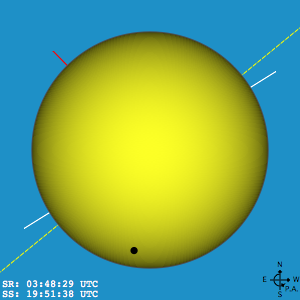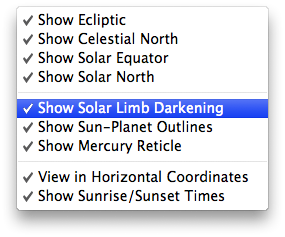Sun-Planet Diagram
The transit Sun-Planet diagram is displayed in real time at the observer’s location. Two orientations are available:
- the zenith up or horizontal coordinates (view matches what you see through binoculars),
- the celestial north up or equatorial coordinates.

|

|
The Sun-Planet diagram not only shows the relative positions, but also displays:
- the ecliptic
- the celestial north
- the solar equator
- the solar north
- the solar limb darkening
- the Sun and planet outlines
- the reticle for Mercury
- the coordinate system in use (horizontal or equatorial)
- the elevation and azimuth of the Sun
- the sunrise and sunset times
- the parallactic angle value when in horizontal mode
A contextual menu that can be invoked with a right click over the Sun-Planet diagram will let you select various options:
- enable/disable the display of the ecliptic as a dotted yellow line
- enable/disable the display of the celestial north as a red tick mark
- enable/disable the display of the solar equator as two white tick marks on each side of the Sun
- enable/disable the display of the solar limb darkening
- enable/disable the display of the Sun and planet outlines
- enable/disable the display of the reticle for Mercury
- enable/disable the switch between horizontal and equatorial coordinates
- display or hide the solar elevation and azimuth in degrees
- enable/disable the display of the times of sunrise and sunset at the bottom left corner
- enable/disable the display at the top right corner of the parallactic angle value when in horizontal mode
|

